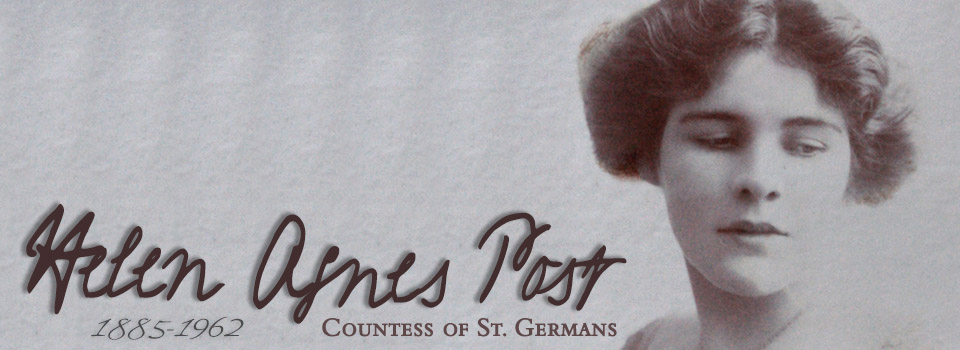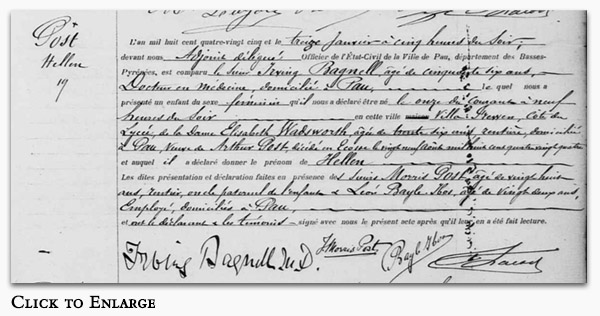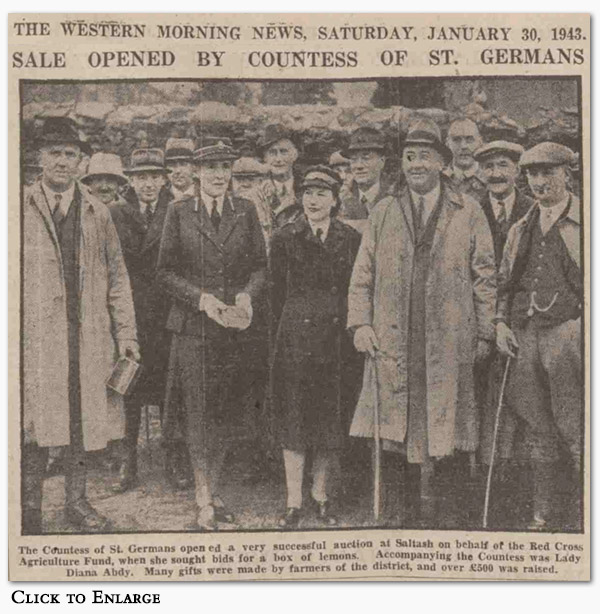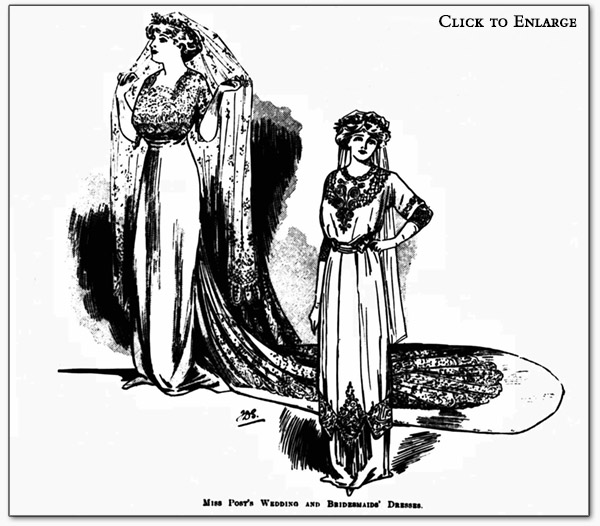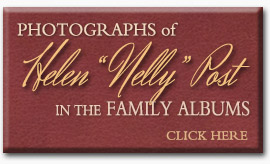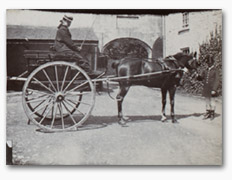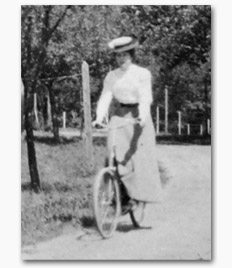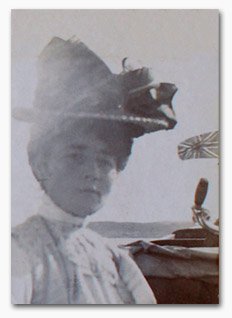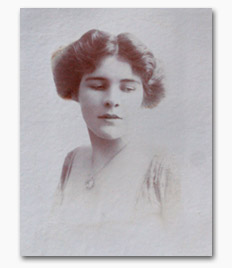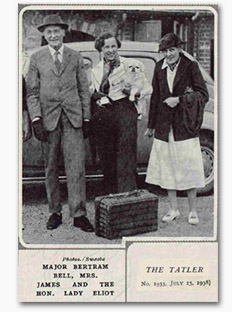Helen Agnes Post (1885 - 1962)
Helen was the only child and daughter of Arthur Post and Elizabeth Wadsworth, known to family and friends as Nellie.
Nellie Eliot is an ongoing "research project", so I haven't finished a full biography for her page here. For the time being, this page features various transcriptions and facts presented below in chronological order. (Go to the bottom part of the page to read the fabulous description of Monty and Nellie's impressive wedding.)
Not too many photos of Nellie survive in the Port Eliot albums, but there is an album that belonged to her during her life at Fota House. There are some photos in the right-hand column here, and you can also click on the button to see more photos.

— The following was written by Peregrine, 10th Earl St. Germans, when reminiscing about the decorations in the Salon at Port Eliot:
Immediately after World War II, when everything was rationed, including furnishing materials, my American grandmother made curtains for the salon from the huge Irish-linen tablecloths woven for an ancestor who was lord lieutenant of Ireland. She had the linen hand-painted with blue stripes and used simple wooden batons. The house carpenter - a man known to us children as Mr. Patton - constructed an arrangement of Art Deco-style ornamental mirrors to go between the windows. I remember Mr. Patton well; he had fought on the Khyber Pass against the Afghans and, in retirement, painted primitive seascapes in the manner of Alfred Wallis on the inside of his shed down on the quay.

— "Morning Post" 14 Jan 1885, page 1:
POST.– On the 11th inst., at Pau, France, Mrs. Arthur Post, of a daughter.
— Translation of Nellie's Official Register of Birth (Pau, France):
On January 13th, 1885, at 5.00 pm, Mr Irving Bagnell (56), medical doctor, domiciled in Pau, appeared before the deputy officer of Civil Affairs of Pau (Basses-Pyrenees). He declared that a female child was born on the 11th of that same month, at 9.00 pm, in the Villa Frewen (Cote du Lycee), to Mrs. Elisabeth Wadsworth (36), of private means, living in Pau. She is the widow of Arthur Post, who died in Scotland on August 29th, 1884. The doctor also declared that her first name was Hellen.

— "Evening Star" 29 Jan 1907, page 3:
Although the illness of King Oscar of Sweden necessitated the postponement of the visit of Miss Nelly Post and Miss Claire Frewen to the Royal Palace at Stockholm, these young ladies left London last week to stay with Princess Gustavus (nee Princess Margaret of Connaught), a future Queen of Sweden. This is the first time since her marriage two years ago, says a London contemporary, that the Princess has asked any of her former friends to visit her in her new home.
Miss Post, the daughter of Lady Barrymore, is an exceedingly popular girl in society, and is a frequent visitor to Princess Patricia of Connaught at Bagshot Park. Miss Frewen’s mother was one of the three Misses Jerome, the elder of whom was the widow of Lord Randolph Churchill, and is now Mrs. George West. The invitations to the Court of Sweden were received over two months ago, and since then the two American girls have been studying Swedish with the greatest perseverance. Mrs. Moreton Frewen accompanies them as chaperon, and the visit will be of about three weeks’ duration.
— "Dundee Courier" 13 Dec 1907, page 8:
SOUVENIR OF KING OSCAR.– The death of King Oscar of Sweden recalls the visit last year of two Anglo-American girls prominent in London society to the Royal Palace at Stockholm. These young ladies – Miss Nelly Post, the daughter of Lady Barrymore, and Miss Claire Frewen, daughter of Mrs. Moreton Frewen, and niece of Mrs. George Cornwallis West – were close personal friends of the new Crown Princess of Sweden, who as Princess Margaret of Connaught invited them to her marriage two years ago at Windsor, and afterwards entertained them at Bagshot Park. Miss Post and Miss Frewen spent some four weeks at the Swedish Court. During this time they saw a good deal of the late King, who spoke English well. Before leaving Stockholm King Oscar conferred upon them the Order of Innocence - a special medal attached to a white ribbon.
— "Barnsley Chronicle" 04 Jan 1908, page 1:
The late Kind Oscar was extremely fond of his grandson's young English wife. The old King spoke English very well, and liked to air his knowledge of the language. His affection extended not only to the Princess and her two fine little boys, whose birth ensured the continuance of his Royal line, but also to her friends from England, who came to Stockholm to see her. When two of these, Miss Nellie Post, Lady Barrymore’s daughter by her first marriage, and Miss Clare Frewen, daughter of Mr. Frewen and niece of Mrs. George Cornwallis-West, visited the Princess at Stockholm a year ago, King Oscar showed his interest in the two pretty girls by conferring on them the Order of Innocence.
— "Daily Telegraph & Courier" 16 Mar 1909, page 12:
Mrs. Adair and her niece, Miss Helen Post, who have been staying for some time in Japan, are expected home in the course of a few weeks. Mrs. Adair has greatly benefited by her trip, and hopes to be well enough to entertain during the forthcoming London season. She expects to have a house party at Adair Place for Ascot week.

— Attended the "Hundred Years Ago" ball held at Albert Hall, London, in June 1912. She dressed as Lady Peel in a "cream and orange shot satin gown veiled with silver gauze."
— "Sheffield Independent" 13 Feb 1920, page 4:
MRS. MONTAGUE ELIOT.
Mrs. Montague Eliot, who was one of the sponsors at the christening of the infant son of Count Raben in the Marlborough House Chapel, is an American by birth. As Miss Helen Post, she had a place of her own in the smart American set in London. Indeed, she acquired the nickname of Miss "Washington" Post, for the reason that she was a first-rate dancer and was often chosen to be leader of the cotilion, a dance then much in vogue, but little heard of in these mad days of the jazz. Her mother is now the wife of Lord Barrymore, a keen yachtsman and Admiral of the Cork Yacht Club, an organsation established exactly two hundred years ago.
Mrs. Montague Eliot's maternal grandfather was a general in the United States Army.
— "Framlingham Weekly News" 15 Dec 1934, page 3:
WOMAN'S LOVE FOR ANOTHER'S CHILDREN
The love of a lonely woman for the children of another was revealed at an inquest at Paddington, London.
Dinah Thureau was once employed by the family of Lady Helen Eliot [once Nellie's governess years before]. She had not any relatives, and the world for her was in the service of her employers and their children. They were fond of her. When she retired she was given a pension. With it she could live comfortably, alone. She even managed to save. In later years she had a friend – her canary. She cared for the pet, and in a letter she left before she died she said: "My suffering is too great, so I am taking my life. Wire to Lady Eliot. Please look after my little canary. His seed is in the wardrobe." The old woman – she was 70 – had been out of service of the family of Lady Helen Eliot for 30 years. yet the kindness had not been forgotten. The money she managed to save she left to Lady Eliot's children, and the canary will be the care of Lady Eliot.
— "Western Morning News" 29 Jan 1943, page 3:
RED CROSS WORK
CORNISH APPEAL FOR MORE SUPPORT THIS YEAR.
The Countess of St. Germans, vice-president of East and South Cornwall Group, Red Cross, in opening an auction sale at Saltash yesterday, appealed for increased support in a year in which Red Cross work would be more extensive than in the past three years.
Speaking to farmers, the Countess said that the Red Cross Agriculture Fund had raised £1,500,000 up to December. Accompanying her was Lady Diana Adby, Assistant County Director of the Red Cross.
— "Western Morning News" 01 Apr 1943, page 3:
Saltash Flower Show.
The Countess of St. Germans, in opening the 14th annual spring flower and bulb show at the School Hall, Saltash Baptist Church, yesterday, congratulated the people of Saltash on producing such a magnificent display.
A wartime cake competition, the winner being Mrs. Pearce, formed part of the programme, followed by the presentation of prizes by Mrs. Treweeke. The silver challenge cup went to Mrs. H. Morgan, and the children’s cup to Pamela Hodge, aged 11. In the evening there was a concert, arranged by Mr. Mike Cook and his Plymouth entertainers.
— "Western Morning News" 30 Sep 1943, page 2:
ST. GERMANS THANKED.
Mr. Walter Brett, chairman of the Horticulture Committee of the Red Cross Agriculture Fund, has written a letter of thanks to the Countess of St. Germans, Port Eliot, Cornwall acknowledging from cheque for £671 12s., resulting from the recent Victory Garden Show and Fete at St. Germans.
In his note Mr. Brett says: “All the hard work you must have put into the show is thoroughly appreciated; it is wonderful, indeed.”
— "Western Morning News" 15 Nov 1943, page 2:
SIX LEMONS – £14
Callington Tribute to Red Cross
Six lemons fetched £14 for the Red Cross Agricultural Fund when auctioned during an interval at a concert given by the Delabole Optimists at Callington Town Hall on Saturday. They were sent home from Sicily by a Callington man, Pte. Stanley Jago, R.E., for sale on behalf of charity.
Callington held its fourth annual Red Cross sale, which was formally opened by the Countess of St. Germans, who was introduced by Mr. P.M. Hambly (chairman of committee), supported by Lady Diana Abdy, Corpl. Macfarlane, R.E., a repatriated prisoner, made an appeal at the opening for generous response to the day’s effort. “Life in a prison camp can be miserable and unpleasant, but the Red Cross has done much to make things brighter for me and those left behind,” said Corpl. Macfarlane.
A bouquet of flowers was presented to the Countess by Miss Bridget Hambly and a posy to Lady Abdy.
Townspeople, farmers, scholars of Callington senior and junior schools, and members of Callington Allotment and Home Gardeners’ Association brought liberal gifts of live and dead stock for sale. The day’s proceeds amounted to over £260.
— "Western Morning News" 23 Feb 1945, page 3:
AUCTION SALE SUCCESS AT SALTASH.
The Countess of St. Germans, wearing the uniform of the Red Cross, and accompanied by Lady Diana Abdy, similarly attired, conducted the first auction at the annual sale in Saltash Market yesterday in aid of Saltash, St. Germans, and Antony Red Cross Agriculture Fund.
The Countess, introduced by the Mayor of Saltash (Ald. J.F. Ashton), thanked all present in the name of the Red Cross for the work they were doing. She received a bouquet from Rosemary Tablyn.
A calf, for which she invited bids, was sold and resold many times, realizing £125 10s.
Messrs. Vosper and Kivell conducted other auctions of livestock, puppies, and vegetables, which fetched £34. Competitions for whisky, a mystery parcel, and 12 boxes of matches added £17 4s., while a previous effort at Trematon, arranged by Mr. H. Pethick produced £55 10s. 9d.

— "Birmingham Daily Post" 06 Sep 1962, page 17:
Countess 'Killed Herself'
A coroner in Gibraltar ruled yesterday that Countess (Helen Agnes) St. Germans, who was found dead in a hotel room last week, killed herself by taking an overdose of sleeping capsules. The countess, aged 77, was the widow of the eighth Earl of St. Germans. She had arrived the day before from Tangier, home of her son, Mr. Montague Robert Vere Eliot, who appeared in court.
She was the daughter of Lady Barrymore and the late Arthur Post, of New York.
— "The Times" 07 Sep 1962, page 17:
COUNTESS OF ST. GERMANS
Dr. A.L. Rowse writes:–
The death of Nellie St. Germans leaves a sad gap in the hearts of those who knew her - especially in Cornwall, where for the past three decades she made Port Eliot a centre of welcoming hospitality and lit that somewhat sombre great house with her charm. With a mocking sense of humour, often turned against herself, she could be amusing about the discommodities of “Port” looking northwards up the slopes of Repton’s park, the south aspect of the house right up against the ancient twin-towered priory church, and the sense of the vanished monks hanging over the plast. Yet there one saw her at her best, against the background of all those early Reynoldses and Opies, the eighteenth century landscapes, the Rembrandt recently attested there.
She took a living interest in it all, for she was a clever woman, with intellectual interests, very well read, with innate discrimination and distinction which shone in her grace and poise, no less than in those beautiful eyes, that understood everything. She was indeed the life of the place, keeping it youthful beside her so-much-older husband, Monty, with his old-fashioned courtesy and more aloof bearing.
The blood of a famous American family ran in her veins - the Wadsworths of Geneseo in Upper New York state, who have provided so many men of distinction to American public life. Perhaps her intellectual bent, her sparkle of mind, came from there; her kindness of heart, the warmth of her personality, were all her own. Charles Henderson used to say that she was the original of Shaw’s enchanting Mrs. Hushaby in “Heartbreak House.” This she denied the last time I saw her, for underneath the enchantment there was a real modesty.
Very frail and flower-like these last years, racked by asthma and bronchitis, she nevertheless bore up bravely by Monty’s side to the last; and then took refuge from the English winter, a distress to her with her illness, in Tangier. Her passing is like a lambent flame going out - leaving yet the memory of it, of her smile and animation, the vivacity and grace, not to be forgotten.
— "England & Wales, National Probate Calendar" (1963, S, St, 59):
St. Germans (Countess of) the Right Honorable Helen Agnes of Casa Azul Place du Cadi Djemaa-el-Mokra, Tangier, widow, died on the night of 31 August/ 1 September 1962 at Queens Hotel 1 Grand Parade, Gibraltar. Probate London 25 March to Anthony Gosselin Trower and Michael Theodore Pelloe and Sir William Gosselin Trower, solicitors.
Effects £7,698 0s. 9d. in England.
Resealed Gibraltar 19 July 1963.

Nellie Post's wedding to Monty Eliot was one of the big news items of the day, particularly as it was one of three marriages in a two-week period where an American girl married a gentleman of the British Peerage. Another interesting fact is that the wedding took place in London, when the country was still in mourning for the recently departed King Edward VII. This accounts for most of the guests arriving in black or grey and the bridal party wearing silver and grey. The following transcriptions are some very interesting descriptions of the lavish ceremony and celebration.
— "Cheltenham Looker-On" 25 Jun 1910, page 7:
The Marriage was celebrated on Wednesday afternoon at St. George's Church, Honver Square, of Mr. Montague Eliot, one of the Grooms in Waiting to the late King Edward, son of the late Colonel the Hon. Charles Eliot and Hon. Mrs. Eliot, and nephew of the Earl of St. Germans, to Miss Helen Agnes Post, daughter of the late Mr. Arthur Post and of Lady Barrymore. The bride arrived at half-past two o'clock, accompanied by Lord Barrymore, who afterwards gave her away, and was met inside the entrance by her bridesmaids and pages. The bridesmaids were the Hon. Dorothy Smith-Barry, her half-sister; Lady Wenteth Ponsonby, cousin of the bridegroom; Miss Coxwell Rogers, Miss Margaret Trefusis, Miss Conellan, and Miss Clare Frewen. The bride was wearing a robe of white satin with train of anitque lace over chiffon. Her old lace veil, lent by Lord Barrymore's sister, Mrs. Oswald of Auchincruive, was worn over a wreath of orange flowers, and her ornaments included an aquamarine pendant set with diamonds, given her by the bridegroom. Her train was carried by two little pages attired in white satin suits, Lord Clonmore, son of the Earl and Countess of Wicklow, and Master Horace Renshaw, son of Mr. and Lady Winifred Renshaw. Her bridesmaids wore white satin dresses with embroidered chiffon tunics and tulle veils over wreaths of silver rose leaves. They carried sheaves of white lilium longiflorum tied with silver ribbon, and wore blue pendants set in diamonds, the gifts of the bridegroom. Viscount Duncannon, M.P. for Cheltenham, discharged the duties of best man. Hundreds of magnificent presents were received; among them a large silver bowl from the Duke and Duchess of Connaught, a tall seilver flower vase from teh Crown Prince and Crown Princess of Sweden. Lady Barrymore's gifts to her daughter included a diamond and ruby necklace, a diamond ring, a gold fitted dressing case, and all the furniture for her new house. From Lord Barrymore there is a grand piano, and the Hon. Mrs. Charles Eliot gives her son a canteen of table silver. The Earl and Countess of Bessborough sent a large silver tea-tray, and Viscount Duncannon, M.P., a large silver-gilt pheasant. There was a large number of guests, the ladies on entering the church being handed bunches of Caroline Testout roses, and the men received carnation buttonholes. Miss Post is the third American girl to be married into our peerage within a fortnight.
— "Daily Telegraph & Courier" 23 Jun 1910, page 12:
FASHIONABLE WEDDINGS.
MR. MONTAGUE ELIOT AND MISS HELEN POST.
In St. George's Church, Hanover-square, a large congregation assembled for another Anglo-American wedding, the bridegroom, Mr. Montague Eliot, being the second son of the late Colonel the Hon. Charles Eliot and grandson of the third Earl of St. Germans, and the bride the daughter of the late Mr. Arthur Post and of Lady Barrymore, and niece of Mrs. Adair. The central passage, the chancel, and choir stalls were decorated with white Madonna lilies, palms, and maple foliage, while on the altar was a cross of white flowers with clusters of lilies at either side. The choristers, Canon Edgar Sheppard, D.D. (Sub-Dean of the Chapels Royal), who performed the marriage rite, and the Rev. Prebendary Anderson, rector, awaited the entrance of the bride at the west door. She arrived with her stepfather, Lord Barrymore, who afterwards gave her away. Her dress was a simple one, made with a train, and was of softest white satin, the yoke and the sleeves to the elbows being of old lace. The Court train, worn from the shoulders, was of white mousseline de soie, and three times flounced across with lace, while the deep and prettily graduated end of the round train was softest white satin lumineuse. The veil was arranged over a tiara-shaped wreath of orange blossoms, of which a cluster caught the lace at the side of the yoke. There were two pages, Lord Clanmore (son of the Earl and Countess of Wicklow) and Master Tom Renshaw (son of Mr. Arthur and Lady Winifred Renshaw), dressed in white Ottoman silk, the tunics fastened with plain silver buttons. Six bridesmaids attended — Lady Gweneth Ponsonby, the Hon. Dorothy Smith Barry, Miss Margaret Trefusis, Miss Coxwell Rogers, Miss Claire Frewen, and Miss Connollan. Their dresses were of soft white satin made in classical style; their veils of tulle under wreaths of silver bay leaves, and they carried sheaves of white Annunciation lilies. The choristers preceded them up the church singing, "Lead us, Heavenly Father." The bridegroom, with Viscount Duncannon, M.P., his cousin and best man, awaited the bride, and when she joined him the service began. At its conclusion, while the register was being signed, the organist played the prelude to "The Meistersingers," and when the bridal party passed down the church a Wedding March composed for the occasion by Mr. H.S. Goodhart Rendel, Mus. Bac., cousin of Lord Rendel, was played.
As each lady entered she was handed a dress cluster of large pink roses, while each man was given a white carnation button-hole. These decidedly did lend colour and brightness to the large assemblage. Lady Barrymore wore a charming dress of dove-grey voile de soie. A long tunic deeply edged with raised silk embroidery in the same colour fell over the long skirt. A hat of Tegal straw in the same colour was worn, trimmed with grey feathers shaded to palest mauve. Mrs. Adair had a gown of the old-world tone of mauve which is now in fashion again. It was of crepe de Chine, and over it was a long mantle of net the same colour, embroidered with silk. A straw hat, also the same shade, was worn, trimmed with mauve ostrich plumes. The hon. Mrs. Charles Eliot, mother of the bridegroom, had an aluminium grey chiffon velours dress, and a bonnet of grey lace, embroidered with silver and trimmed with aluminium roses. With her sat her sister, the Countess of Bessborough, whose coat and skirt were of grey tussore, embroidered in the same shade; a grey tulle and flowered toque was worn. The Countess of Dartrey was present at the church, little thinking how soon she was to hear of the accident to her plucky sister, Mrs. Henry Hohler, at the Army Pageant, and with her was her daughter, Lady Mary Dawson. The Earl and Countess of St. Germans came together, Lady St. Germans in black net and lace and a jetted toque. Priscilla Countess Annesley was in black, with white plumes in her hat, and wearing a white ostrich feather boa. The American Ambassador was present, and was one of those who signed the register. The Marchioness of Tweeddale wore a coat and skirt of broche ash grey silk having a touche of mauve in it, and patterned with a sprig of black; a black hat was worn, finished with ash grey ostrich plumes. The Marchioness of Dufferin was dressed in lavender-grey silk muslin, embroidered in shaded-grey floss silk, a whit chip hat was worn, on the crown of which was a mass of silk gauze roses in a pale shade of French grey. The Marchioness Camden was in ivory-white, embroidered voile, and wore a black hat. The Dowager Countess of Arran brought Lady Winifred Gore in white with a black hat; Mrs. Ralph Peto was wearing a white muslin dress, embroidered in pale mauve, and over it a loose coat of soft black, and a black straw hat, with shade black and white plumes falling over the crown. The Hon. Mrs. Harry Lawson was in unrelieved black; Lady Eva Wyndham-Quin, with an ash-grey soft silk dress, wore a black hat; Madame de Domingues was all in black. Mrs. George Conrwallis-West was in black, relieved with white; the Hon. Lady Talbot also had her black attire mingled with a little white. The Countess of Wicklow, in grey-silver silk, patterned with black, wore a white chip hat with a wreath of white roses across the top.
After the wedding, Lady Barrymore held a reception at 20, Hill-street, where the wedding presents were greatly admired. The Duke and Duchess of Connaught sent the bride a silver bowl of graceful shape, and inscribed as a wedding gift from their Royal Highnesses, the Crown Prince and Princess of Sweden a Swedish silver vase, Princess Patricia of Connaught an enamelled and jewelled sunshade-handle, and Princess Frederica of Hanover a crystal and silver vase. Lady Barrymore gave her daughter a house fully-equipped and furnished in Wyndham-place, also a diamond and ruby necklace, a gold-fitted dressing case, and a diamond ring. Lord Barrymore gave her a grand piano. The American Ambassador and Mrs. Whitelaw Reid's gift was an old silver tray, with coffee-pot, sugar-basin, and milk-jug. Mrs. Adair's gift was a diamond tiara. Later in the afternoon Mr. and Mrs. Montague Eliot left for France and Holland; the bride's travelling dress and hat were grey.
